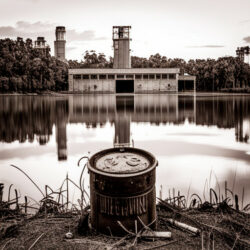A Breakdown of the Contaminated Camp Lejeune Water Distribution Plants
Historic Camp Lejeune is an icon in the United States Marine Corps — it’s home to a number of fighting and support units such as the II Marine Expeditionary Force, 2nd Marine Division, and 2nd Marine Logistics Group, according to the base’s webpage.

Camp Lejeune is located in North Carolina and gets its name from General John A. Lejeune, Commandant of the Marine Corps from 1920 until 1929. He was also an early advocate of amphibious assaults that would come to characterize the Marines’ activities in the Pacific theater during World War II.
In recent years, though, Camp Lejeune has become associated with something far less honorable: the exposure of military service members and their families to contaminated water.
The Agency for Toxic Substances and Disease Registry (ATSDR) estimates that as many as one million service members, their families, and civilians may have been exposed to toxic chemicals in the water at Camp Lejeune and nearby Marine Corps Air Station (MCAS) New River.
What Happened to Camp Lejeune’s Water Supply?
In 1982, the Marine Corps uncovered that water from two of Camp Lejeune’s eight water treatment plants was contaminated with certain volatile organic compounds (VOCs). These two treatment facilities were the Tarawa Terrace water treatment plant and the Hadnot Point water treatment plant.
Water treatment plants are responsible for treating water and making it safe for human consumption and use before the water leaves the treatment plant. The water then travels to homes and businesses, where it is used for drinking, cooking, and bathing, among other uses.
In the case of Tarawa Terrace and Hadnot Point, these plants collected water from several wells before treating it and dispensing it to consumers. Several of the wells that both plants draw water from stored contaminated groundwater, which then became mixed with water from other sources inside the plant and distributed to those serviced by the plants.
The Tarawa Terrace water treatment plant is located north of Camp Lejeune, along the New River. Tests revealed that the plant’s water was contaminated primarily by the VOCs perchloroethylene or tetrachloroethylene, abbreviated as PCE.
The source of the contamination was traced to a local dry cleaning company, ABC One-Hour Cleaners, located off base. It is believed that the waste disposal practices of the cleaners led to the contamination at the Tarawa Terrace plant.
The Hadnot Point water treatment plant was located south of Tarawa Terrace and along the New River. Hadnot Point’s drinking water was found to be contaminated by multiple VOCs, including PCE, trichloroethylene (TCE), and benzene.
The sources of the contamination were found to be underground storage tanks that leaked, industrial spills, and nearby waste disposal sites.
In the case of the Tarawa Terrace plant, the ATSDR concluded that the plant’s water contained an unsafe level of contaminants for 346 months, from November 1957 until February 1987. Tarawa Terrace’s wells were shut down in February of 1985.
For the Hadnot Point plant, ATSDR concluded that this plant’s water had an unsafe level of contaminants from August 1953 until January 1985.
The presence of VOCs and toxins in the Camp Lejeune drinking water was anywhere from 240 to 3,000 times the levels that were considered safe by the Environmental Protection Agency (EPA).
Consequences of VOC Exposure
Exposure to any of the VOCs discovered in the water at Camp Lejeune has been linked to numerous serious and sometimes fatal health conditions. A person’s presence at Camp Lejeune or nearby MCAS New River for as few as 30 days is believed to be sufficient to lead to the development of these health issues.
These toxic substances can enter the human body primarily through drinking or showering with water that has been contaminated.
The VA now recognizes a number of health conditions that are likely caused by exposure to VOC-laden water. These conditions include the following:
- Bladder cancer, kidney cancer, breast cancer, and esophageal cancer
- Infertility in women and miscarriages
- Hepatic steatosis, or “fatty liver disease”
- Leukemia and non-Hodgkin’s lymphoma
- Multiple myeloma and myelodysplastic syndromes
- Parkinson’s Disease
If a veteran or a veteran’s family member was stationed at Camp Lejeune or MCAS New River for 30 cumulative days between August 1953 and December 1987, and they subsequently developed any of these conditions, they are likely entitled to compensation.
There may be additional health conditions that were either caused by or exacerbated by exposure to contaminated drinking water. If the affected person can establish a connection between their condition and toxic water exposure, there is a good chance that they can receive benefits or compensation if they meet other eligibility requirements.
Who Is Affected by the Contaminated Water at Camp Lejeune?
Military service members, their families, and others who lived and worked at Camp Lejeune or MCAS New River between August 1953 and December 1987 were potentially exposed to unsafe drinking water.
It was not until 1982 that the Marine Corps discovered unsafe levels of toxins in the water, and some of the most contaminated wells were not shut down until 1985.
Long-term exposure to the toxic water is not necessary to develop health complications. Even those who were present for 30 days at Camp Lejeune and drank or used its water during the relevant time period are at risk of developing health complications.
The Tarawa Terrace plant and the Hadnot Point plant both supplied residential areas of Camp Lejeune that were used by enlisted personnel and their families. This means that young men and women, as well as young children, were at risk of harm.
What Happened After Contaminated Wells Were Closed?
The story of the toxic water at Camp Lejeune and the two water treatment plants that distributed contaminated water to those stationed at the base does not end in 1987.
It took until 1999, nearly 14 years after the most contaminated wells at Camp Lejeune were closed, before the Marine Corps began notifying individuals who may have been exposed to toxic chemicals.
One of the earliest Camp Lejeune toxic water lawsuits was filed ten years later, in 2009. Laura Jones and her husband, a Marine, were stationed at Camp Lejeune from 1980 until 1983. While living on base at Camp Lejeune, their residence received water from one of the plants with contaminated water.
Ms. Jones’s lawsuit alleged that she developed non-Hodgkin’s lymphoma after being exposed to VOCs in the base’s water supply.
In 2012, President Obama signed the “Honoring America’s Veterans and Caring for Camp Lejeune Families Act of 2012,” which permitted service members and their family members who met certain eligibility requirements to begin receiving health care benefits from the Department of Veterans Affairs.
This Act was followed ten years later by the Camp Lejeune Justice Act of 2022, allowing certain eligible individuals to sue and recover damages for the harm they suffered as a result of the base’s toxic water.
The requirements for these lawsuits are rather strict, however, and plaintiffs must show that they meet the law’s eligibility requirements before they can proceed with their claim.
How to Get Started with a Camp Lejeune Toxic Water Lawyer’s Help
A VA disability claim as well as a lawsuit pursuant to the Camp Lejeune Justice Act have strict eligibility requirements. Having a knowledgeable attorney from a reputable law firm who is familiar with these claims can help you evaluate your situation and determine what legal rights you have.
Consider hiring a law firm with experience handling Camp Lejeune toxic water lawsuits. Many claims and lawsuits have been presented in the years since Ms. Jones filed her suit, and some firms have used the intervening years to develop knowledge on helping Camp Lejeune victims.
You can also complete our contact form on the side of this page to have an experienced attorney evaluate your case for free.




